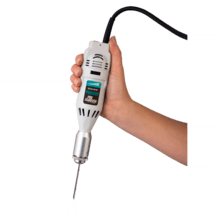Homogenizer
Mechanical homogenizer
A homogenizer is a piece of laboratory or industrial equipment used for the homogenization of various types of material, such as tissue, plant, food, soil, and many others. Many different models have been developed using various physical technologies for disruption. The mortar and pestle, already used for thousands of years, is a standard tool even in modern laboratories. More modern solutions are based on blender type of instruments (also known in the kitchen), bead mills, ultrasonic treatment (also sonication), rotor-stator mechanical, high pressure, and many other physical forces.[1]

There are often many different names for the same piece of mechanical homogenizing equipment, including Cell Lysor, Disperser, High Shear Mixer, Homogenizer, Polytron, Rotor Stator Homogenizer, Sonicator or Tissue Tearor.[3]
Cell fractionation is done by homogenizer to release the organelles from cell. Whereas older technologies just focused on the disruption of the material, newer technologies also address quality or environmental aspects, such as cross-contamination, aerosols, risk of infection, or noise. Homogenization is a very common sample preparation step prior to the analysis of nucleic acids, proteins, cells, metabolism, pathogens, and many other targets.
Optical Homogenizer
In the field of optics, a homogenizer is an optical device that makes the light beam from a laser or lamp source more uniform in its intensity across its cross-section to enable the light source to provide a more uniform illumination on a surface. Use of a homogenizer in an illumination system is important in consumer applications such as light projectors for movies and industrial applications such as imaging equipment for microlithography for production of semiconductor microchips. Such homogenizers are also called beam homogenizers or beam uniformizers. The main principle in their design approach is to divide the light beam cross-section-wise into multiple segments and then overlap these segments of different intensities into a recombined beam of improved uniformity. A variety of optical homogenization devices have been developed, including fly's-eye lens arrays, hollow and solid light tunnels, beam-folding wedged mirrors and split prisms.
See also
- ↑ , PRO Scientific
- ↑ "Rotor Stator Homogenizers - high shear lab homogenizer". proscientific.com. Retrieved 2017-11-07.
- ↑ "PRO homogenizer for laboratory or industrial homogenization". proscientific.com. Retrieved 2017-11-07.